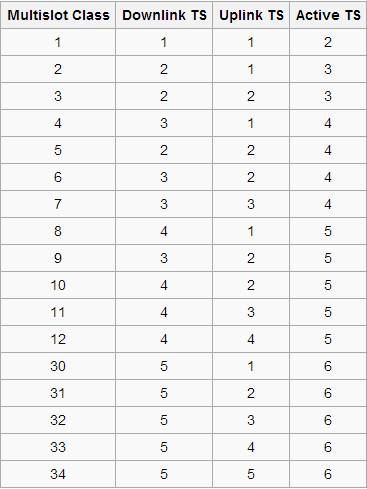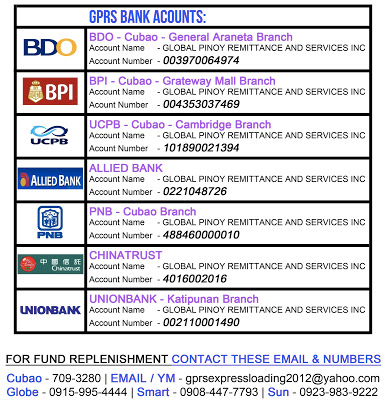The upload and download speeds that can be achieved in GPRS depend on a number of factors such as:
- the number of BTS TDMA time slots assigned by the operator
- the channel encoding is used.
- the maximum capability of the mobile device expressed as a GPRS multislot class
Multiple access schemes
The multiple access methods used in GSM with GPRS are based on frequency division duplex (FDD) and TDMA. During a session, a user is assigned to one pair of up-link and down-link frequency channels. This is combined with time domain statistical multiplexing which makes it possible for several users to share the same frequency channel. Thepackets have constant length, corresponding to a GSM time slot. The down-link uses first-come first-served packet scheduling, while the up-link uses a scheme very similar toreservation ALOHA (R-ALOHA). This means that slotted ALOHA (S-ALOHA) is used for reservation inquiries during a contention phase, and then the actual data is transferred using dynamic TDMA with first-come first-served.
Channel encoding
The channel encoding process in GPRS consists of two steps: first, a cyclic code is used to add parity bits, which are also referred to as the Block Check Sequence, followed by coding with a possibly punctured convolutional code. The Coding Schemes CS-1 to CS-4 specify the number of parity bits generated by the cyclic code and the puncturing rate of the convolutional code. In Coding Schemes CS-1 through CS-3, the convolutional code is of rate 1/2, i.e. each input bit is converted into two coded bits. In Coding Schemes CS-2 and CS-3, the output of the convolutional code is punctured to achieve the desired code rate. In Coding Scheme CS-4, no convolutional coding is applied. The following table summarises the options.

- This is rate at which the RLC/MAC layer protocol data unit (PDU) (called a radio block) is transmitted. As shown in TS 44.060 section 10.0a.1, a radio block consists of MAC header, RLC header, RLC data unit and spare bits. The RLC data unit represents the payload, the rest is overhead. The radio block is coded by the convolutional code specified for a particular Coding Scheme, which yields the same PHY layer data rate for all Coding Schemes.
- Cited in various sources, e.g. in TS 45.001 table 1. is the bitrate including the RLC/MAC headers, but excluding the uplink state flag (USF), which is part of the MAC header, yielding a bitrate that is 0.15 kbit/s lower.
- The net bitrate here is the rate at which the RLC/MAC layer payload (the RLC data unit) is transmitted. As such, this bit rate excludes the header overhead from the RLC/MAC layers.
The least robust, but fastest, coding scheme (CS-4) is available near a base transceiver station (BTS), while the most robust coding scheme (CS-1) is used when the mobile station (MS) is further away from a BTS.
Using the CS-4 it is possible to achieve a user speed of 20.0 kbit/s per time slot. However, using this scheme the cell coverage is 25% of normal. CS-1 can achieve a user speed of only 8.0 kbit/s per time slot, but has 98% of normal coverage. Newer network equipment can adapt the transfer speed automatically depending on the mobile location.
In addition to GPRS, there are two other GSM technologies which deliver data services: circuit-switched data (CSD) and high-speed circuit-switched data (HSCSD). In contrast to the shared nature of GPRS, these instead establish a dedicated circuit (usually billed per minute). Some applications such as video calling may prefer HSCSD, especially when there is a continuous flow of data between the endpoints.
The following table summarises some possible configurations of GPRS and circuit switched data services.

Multislot Class
The multislot class determines the speed of data transfer available in the Uplink and Downlink directions. It is a value between 1 and 45 which the network uses to allocate radio channels in the uplink and downlink direction. Multislot class with values greater than 31 are referred to as high multislot classes.
A multislot allocation is represented as, for example, 5+2. The first number is the number of downlink timeslots and the second is the number of uplink timeslots allocated for use by the mobile station. A commonly used value is class 10 for many GPRS/EGPRS mobiles which uses a maximum of 4 timeslots in downlink direction and 2 timeslots in uplink direction. However simultaneously a maximum number of 5 simultaneous timeslots can be used in both uplink and downlink. The network will automatically configure the for either 3+2 or 4+1 operation depending on the nature of data transfer.
Some high end mobiles, usually also supporting UMTS, also support GPRS/EDGE multislot class 32. According to 3GPP TS 45.002 (Release 12), Table B.1, mobile stations of this class support 5 timeslots in downlink and 3 timeslots in uplink with a maximum number of 6 simultaneously used timeslots. If data traffic is concentrated in downlink direction the network will configure the connection for 5+1 operation. When more data is transferred in the uplink the network can at any time change the constellation to 4+2 or 3+3. Under the best reception conditions, i.e. when the best EDGE modulation and coding scheme can be used, 5 timeslots can carry a bandwidth of 5*59.2 kbit/s = 296 kbit/s. In uplink direction, 3 timeslots can carry a bandwidth of 3*59.2 kbit/s = 177.6 kbit/s.
Multislot Classes for GPRS/EGPRS

Attributes of a multislot class
Each multislot class identifies the following:
- the maximum number of Timeslots that can be allocated on uplink
- the maximum number of Timeslots that can be allocated on downlink
- the total number of timeslots which can be allocated by the network to the mobile
- the time needed for the MS to perform adjacent cell signal level measurement and get ready to transmit
- the time needed for the MS to get ready to transmit
- the time needed for the MS to perform adjacent cell signal level measurement and get ready to receive
- the time needed for the MS to get ready to receive.
The different multislot class specification is detailed in the Annex B of the 3GPP Technical Specification 45.002 (Multiplexing and multiple access on the radio path)

